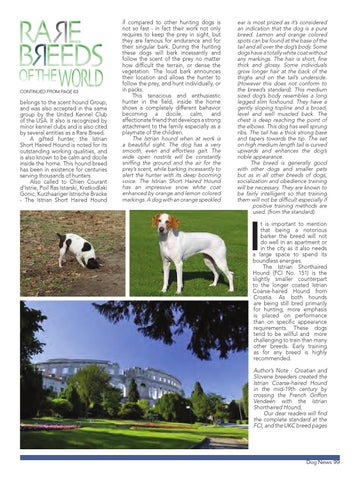RA E BOfRTheEEDS World
Continued FROM page 63
belongs to the scent hound Group, and was also accepted in the same group by the United Kennel Club of the USA. It also is recognized by minor kennel clubs and is also cited by several entities as a Rare Breed. A gifted hunter, the Istrian Short Haired Hound is noted for its outstanding working qualities, and is also known to be calm and docile inside the home. This hound breed has been in existence for centuries serving thousands of hunters. Also called to Chien Courant d’Istrie, Poil Ras Istarski, Kratkodlaki Gonic, Kurzhaariger Istrische Bracke - The Istrian Short Haired Hound
if compared to other hunting dogs is not so fast - in fact their work not only requires to keep the prey in sight, but they are famous for endurance and for their singular bark. During the hunting these dogs will bark incessantly and follow the scent of the prey no matter how difficult the terrain, or dense the vegetation. The loud bark announces their location and allows the hunter to follow the prey, and hunt individually, or in packs. This tenacious and enthusiastic hunter in the field, inside the home shows a completely different behavior becoming a docile, calm, and affectionate friend that develops a strong attachment to the family especially as a playmate of the children. The Istrian hound when at work is a beautiful sight. The dog has a very smooth, even and effortless gait. The wide open nostrils will be constantly sniffing the ground and the air for the prey’s scent, while barking incessantly to alert the hunter with its deep booming voice. The Istrian Short Haired Hound has an impressive snow white coat enhanced by orange and lemon colored markings. A dog with an orange speckled
ear is most prized as it’s considered an indication that the dog is a pure breed. Lemon and orange colored spots can be found at the base of the tail and all over the dog’s body. Some dogs have a totally white coat without any markings. The hair is short, fine thick and glossy. Some individuals grow longer hair at the back of the thighs and on the tail’s underside. (However this does not conform to the breed’s standard). This medium sized dog’s body resembles a long legged slim foxhound. They have a gently sloping topline and a broad, level and well muscled back. The chest is deep reaching the point of the elbows. This dog has well sprung ribs. The tail has a thick strong base and tapers towards the tip. The set on high medium length tail is curved upwards and enhances the dog’s noble appearance. The breed is generally good with other dogs and smaller pets but as in all other breeds of dogs, socialization and obedience training will be necessary. They are known to be fairly intelligent so that training them will not be difficult especially if positive training methods are used. (from the standard).
I
t is important to mention that being a notorious barker the breed will not do well in an apartment or in the city as it also needs a large space to spend its boundless energies. The Istrian Shorthaired Hound (FCI No. 151) is the slightly smaller counterpart to the longer coated Istrian Coarse-haired Hound from Croatia. As both hounds are being still bred primarily for hunting, more emphasis is placed on performance than on specific appearance requirements. These dogs tend to be willful and more challenging to train than many other breeds. Early training as for any breed is highly recommended. Author’s Note - Croatian and Slovene breeders created the Istrian Coarse-haired Hound in the mid-19th century by crossing the French Griffon Vendeén with the Istrian Shorthaired Hound, Our dear readers will find the complete standard at the FCI, and the UKC breed pages
Dog News 99
